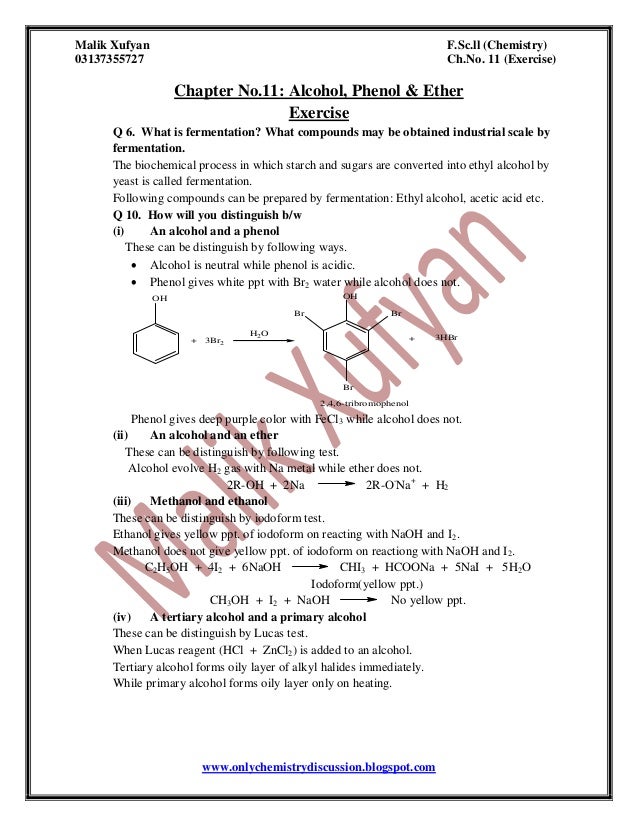
Chemistry (F.Sc.2) Chapter # 11 Exercise Solved - Malik Xufyan
- 1. Malik Xufyan F.Sc.ll (Chemistry) 03137355727 Ch.No. 11 (Exercise) www.onlychemistrydiscussion.blogspot.com Chapter No.11: Alcohol, Phenol & Ether Exercise Q 6. What is fermentation? What compounds may be obtained industrial scale by fermentation. The biochemical process in which starch and sugars are converted into ethyl alcohol by yeast is called fermentation. Following compounds can be prepared by fermentation: Ethyl alcohol, acetic acid etc. Q 10. How will you distinguish b/w (i) An alcohol and a phenol These can be distinguish by following ways. Alcohol is neutral while phenol is acidic. Phenol gives white ppt with Br2 water while alcohol does not. OH + 3Br2 H2O Br Br OH Br + 3HBr 2,4,6-tribromophenol Phenol gives deep purple color with FeCl3 while alcohol does not. (ii) An alcohol and an ether These can be distinguish by following test. Alcohol evolve H2 gas with Na metal while ether does not. 2R-OH + 2Na 2R-O- Na+ + H2 (iii) Methanol and ethanol These can be distinguish by iodoform test. Ethanol gives yellow ppt. of iodoform on reacting with NaOH and I2. Methanol does not give yellow ppt. of iodoform on reactiong with NaOH and I2. C2H5OH + 4I2 + 6NaOH CHI3 + HCOONa + 5NaI + 5H2O Iodoform(yellow ppt.) CH3OH + I2 + NaOH No yellow ppt. (iv) A tertiary alcohol and a primary alcohol These can be distinguish by Lucas test. When Lucas reagent (HCl + ZnCl2) is added to an alcohol. Tertiary alcohol forms oily layer of alkyl halides immediately. While primary alcohol forms oily layer only on heating.
- 2. Malik Xufyan F.Sc.ll (Chemistry) 03137355727 Ch.No. 11 (Exercise) www.onlychemistrydiscussion.blogspot.com R CH2-OH + HCl ZnCl2 heat R CH2-OH + H2O Primary alcohol C R R R OH + HCl ZnCl2 immediately C R R R Cl + H2O Tertiary alcohol (v) 1-propanol and 2-propanol 1-Propanol is primary alcohol while 2-propanol is secondary alcohol. These can be distinguish by Lucas test. When Lucas reagent (HCl + ZnCl2) is added to an alcohol. 2-propanol forms oily layer of alkyl halides within 5-10 mins. H3C CH-OH + HCl CH3 ZnCl2 5-10 mins H3C CH-Cl + H2O CH3 2-Propanol While 1-propanol forms oily layer only on heating H3C-CH2-CH2-OH + HCl 1-propanol ZnCl2 heat H3C-CH2-CH2-Cl + H2O Q 11. Give reasons for the followings: (i) Ethyl alcohol is a liquid while ethyl chloride is a gas. Ethyl chloride has weak dipole-dipole forces while ethanol has strong hydrogen bonding. H O H H O H O C2H5 C2H5 C2H5 hydrogen bonding Due to strong hydrogen bonding in ethanol, its molecules are tightly held together. Thus, ethanol is a liquid while ethyl chloride is gas. (ii) Ethanol has higher boiling point than diethyl ether. Ethanol has strong hydrogen bonding , while diethyl ether have weak vander waal’s forces. H O H H O H O C2H5 C2H5 C2H5 hydrogen bonding Due to strong hydrogen bonding in ethanol, its molecules are tightly held together .
- 3. Malik Xufyan F.Sc.ll (Chemistry) 03137355727 Ch.No. 11 (Exercise) www.onlychemistrydiscussion.blogspot.com Thus, it is difficult to boil ethanol than diethyl ether. Hence, ethanol has higher boiling point than diethyl ether. (iii) Absolute alcohol cannot be prepared by fermentation process. Absolute alcohol cannot be prepared by fermentation process. It is because at high conc. of alcohol, enzyme of yeast becomes inactive and process stops. Actually, alcohol obtained by fermentation process is only up to 12%. This alcohol is further concentrated by distillation to about 95% called rectified spirit. Rectified spirit is further distilled with lime to give absolute alcohol. (iv) Ethanol gives different products with conc. H2SO4 under different conditions. Ethanol gives two types of product in different conditions. High temperature, low alcohol conc. H3C-CH2-OH conc. H2SO4 180oC H2C=CH2 + H2O Low temperature, high alcohol conc. H3C-CH2-OH conc. H2SO4 180o C + H3C-CH2-OH H3C-CH2 H3C-CH2 O + H2O Diethyl ether (v) Water has higher boiling point than ethanol. In water, two hydrogen bonds are formed per molecule while in ethanol only one hydrogen bond is formed per molecule. Thus due to extensive hydrogen bonding in H2O, its boiling point is greater than ethanol. H O H H O H O C2H5 C2H5 C2H5 hydrogen bonding Q 12. How will you convert (i) Methanol into Ethanol H3C-OH + HCl ZnCl2/heat CH3Cl + H2O 2H3CCl + 2Na ether H3C-CH3 + 2NaCl H3C-CH3 + Cl2 light H3C-CH2-Cl + HCl H3C-CH2-Cl + KOH Aqueous H3C-CH2-OH + KCl ethanol methanol (ii) Ethanol into methanol
- 4. Malik Xufyan F.Sc.ll (Chemistry) 03137355727 Ch.No. 11 (Exercise) www.onlychemistrydiscussion.blogspot.com H3C-CH2-OH + HCl ZnCl2/heat CH3-CH2-Cl + H2O H3C-CH2-Cl + KOH Aqueous H2C=CH2 + KCl + H2O H2C=CH2 (i) O3 (ii) Zn/H2O 2H C O H Formaldehyde H C O H + H2 Ni/heat H3C-OH methanol (iii) Ethanol into isopropyl alcohol H3C-CH2-OH + [O] K2Cr2O7 H2SO4 H3C C H O Methanol Acetaldehyde CH3 Mg Br + C O Ether H3C-C-O-MgBr H-OH H H3C-C-OH + Mg Br OH 2-Propanol (isopropyl alcohol) H3C H H3C H H H3C Acetaldehyde (iv) Formaldehyde into ethyl alcohol CH3 Mg Br + C O Ether CH3-C-O-MgBr H-OH H CH3-C-OH + Mg Br OH Ethanol H H H H H H (v) Acetone into ethyl alcohol
- 5. Malik Xufyan F.Sc.ll (Chemistry) 03137355727 Ch.No. 11 (Exercise) www.onlychemistrydiscussion.blogspot.com H3C C CH3 + H2 O H3C CH CH3 OH H3C C H O Acetaldehyde Acetone Ni H3C CH CH3 OH 60% H2SO4 100o C H3C-CH=CH2 + H2O H3C-CH=CH2 (i) O3 (ii) Zn/H2O H3C C H + H2 O Acetaldehyde H C H O Formaldehyde + Ni H3C-CH2-OH Ethanol Q 15. Arrange the following compounds in order of their increasing acid strength and give reasons. H2O,C2H5OH,C6H5OH,C6H5COOH C6H5COOH > C6H5OH >H2O > C2H5OH
